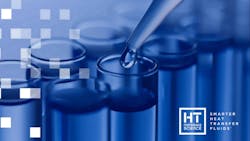Refrigerant additives, arguably the most common air conditioning additives, have been around for at least 30 years. The early additives, known as polarized refrigerant oil additives (PROA), gained favor with the federal government in 1995.
Numerous scientific studies over the next decade, however, showed that refrigeration compressors treated with PROA and run in a steady-state conditions had only negligible improvement in efficiency. The second-generation synthetic refrigeration additives (SRAs) did result in a measurable increase in efficiency, and a number of commercially available SRA products were introduced to market, primarily targeting DX air conditioning.
For chilled water systems and heat pumps, heat transfer fluid additives offer an alternative to refrigerant additives as a more practical solution to improve performance.
One of the companies in that space, HT Materials Science, was formed in 2018 to develop heat transfer fluid additives for the commercial and industrial HVAC market. It introduced its first product, dubbed "Maxwell", in 2020, and by last year had installed the product in more than 15 commercial and industrial facilities around the world. The results so far have been impressive.
HTMS’ pilot installation – which also happens to be its largest installation to date – is the 2,500-ton, water-cooled chiller providing district cooling to a school in Abu Dhabi. That installation was intended to provide data sufficient for an energy efficiency analysis using methodology specified in a formal measurement & verification (M&V) plan, generally conforming to the International Performance Measurement and Verification Protocol (IPMVP), based on improvement of both the chiller COP and the overall system COP.
Based on that analysis, the chiller COP showed a 13.6% energy efficiency improvement and the system COP efficiency improved 9%. The simple payback period (SPP) for the project was 3.8 years and the estimated reduction in carbon emissions was 218.3 tons.
According to HTMS, other installations have shown similar results:
- A multi-purpose building in Saudi Arabia being cooled by two 60-ton air-cooled chillers demonstrated a 15.1% improvement in chiller efficiency, with a 2.2 year SPP and a 25 ton reduction in CO2 emissions;
- A Hong Kong shopping center using two 320-ton water-cooled chillers improved efficiency by 14.8% and eliminated 57 tons of CO2, with a SPP of 2.2 years;
- An Italian university building with a 24-ton heat pump realized a 12.6%, 1.2 ton CO2 reduction, with a SPP of 3.5 years.
Here in the U.S., two well-known pharmaceutical manufacturers installed Maxwell in facilities in Texas and New York. The Texas production plant and warehouse saw a 12.6% efficiency improvement in its two 210-ton air-cooled chillers, a 116 ton reduction in carbon emissions, and a 2.6 year SPP. The other company’s New York office and lab facility improved the efficiency of its two energy recovery systems by 11.2% with a 3.5 year SPP.
The Maxwell product has also demonstrated that it can improve energy efficiency in industrial process cooling applications, resulting in productivity improvement. Another example of a technical innovation that is helping to reduce carbon emissions and mitigate climate change.
They also stand as more reasons for hope against the weekly onslaught of alarming climate news.
